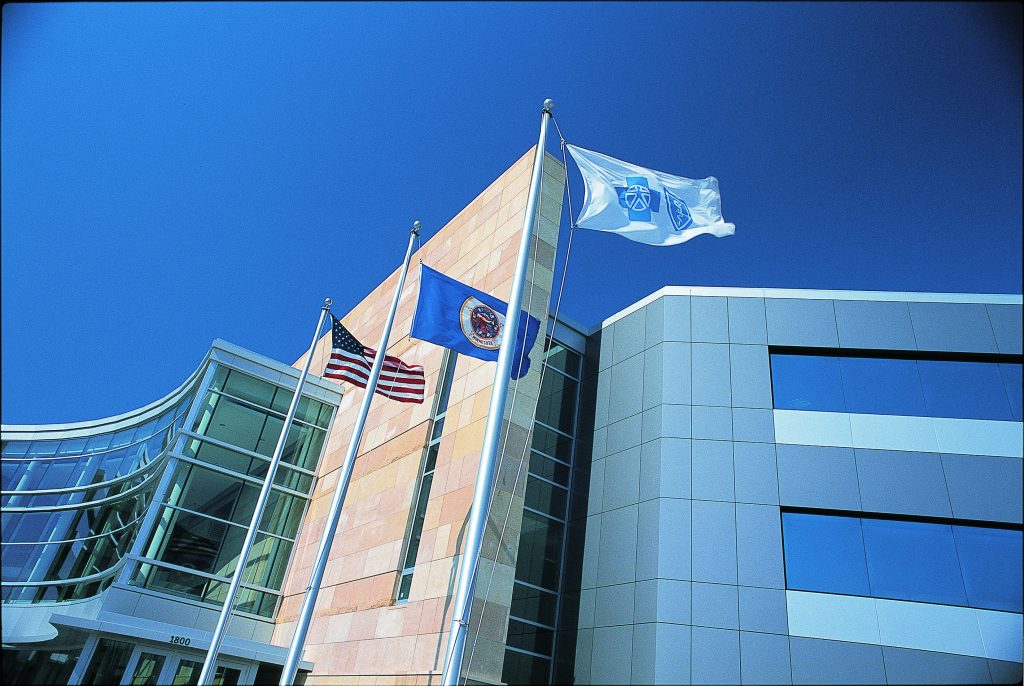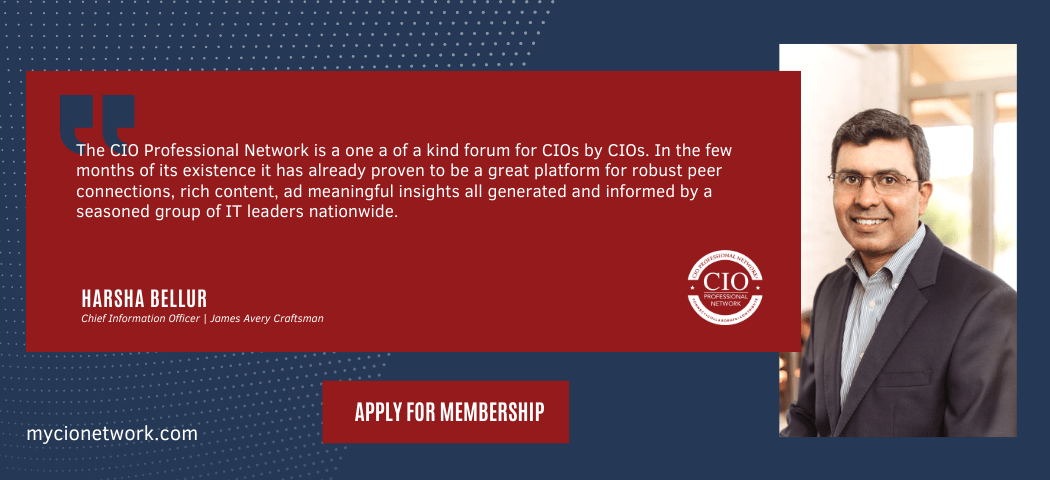Earlier this year, Shahid Alam joined Blue Cross and Blue Shield of Minnesota as Chief Analytics and Information Officer. In this issue, Shahid shared how he decided to pursue a career in technology and analytics, as well as his progression to his current role with the largest health plan based in Minnesota, which covers 2.9 million members in that state and beyond.
Shahid also spoke with us about recognizing reality over hype when it comes to artificial intelligence and blockchain, how he is connecting with his team to carry out his foremost initiative, and the importance of aspiring CIOs opening their horizons and broadening their skillsets to build an appreciation for every part of an organization.

Walk us through your CIO path. How did you decide to pursue a career in technology, and how did you progress to your current organization?
I lost my father when I was 18 years old, right before I moved to the United States. That drove my initial goal of getting into medical science. After deciding medical school wasn’t the best option for me, I ended up on a path that I never could have anticipated or planned in great detail. I never could have guessed that I’d be the CAIO at a major health plan 20 years later.
I wanted to understand both business and computer science, so I pursued education in those areas and started my career as a software engineer. While I was at HealthPartners in Minnesota, which is an integrated healthcare provider and health insurance company, I realized that there are other ways to help patients without being a clinician. It led me to become very passionate about how information, technology and data can be used to tell a patient’s story so that a clinician or a physician can help. In my various roles within HealthPartners, I shadowed physicians and clinicians to better understand what they did on a day-to-day basis so that I had a full appreciation for them. We are all patients, but can you see from a different lens what a patient goes through? It really gave me perspective on how data analytics could help.
When I was debating whether to pursue a master’s degree, I came across a great leader, Sue Knudson, who’s still with HealthPartners. I was lucky enough to observe her, and I also shadowed multiple other leaders in the organization to see what it felt like to be in their shoes on a day-to-day basis. That made me realize that I wanted to go the data analytics and technology route, so I earned my Master’s in Health Informatics and Biostatistics through the University of Minnesota.
From there, I took a role with Centene Corporation. I grew tremendously in my seven years there, and it set the path for me to be in the role that I’m in today for primarily two reasons. I got even closer in terms of solving business problems by leveraging data, technology and analytics, and I was lucky enough to have a few good mentors who took interest in me.
I recognized that technology and data analytics are so adjacent to each other, yet a lot of organizations will have two different leaders – one oversees the technology, the other data analytics. There is an unnatural tension between those two because they’re so adjacent and both are technology focused. I saw what Dr. Craig Samitt and Blue Cross and Blue Shield of Minnesota did as a market-leading move. They removed that traditional tension and pulled both under one leader and one organization to work together. That really got my attention, and I wanted to be able to take advantage of that opportunity.
Would you consider yourself a CIO, a CTO, or a hybrid? Why? What are the essential differences?
It’s more of a combination. In my heart – I’m an analyst. I’m a technologist. I also strongly believe that I am as imperfect as they come, and it’s not a job for one. It’s really a collective effort. Early on in my career, I learned that I have certain strengths but how do I make sure that I have the right team members who can complement my strength and weakness so that collectively we can deliver? I’m very fortunate to have this title, but my strong philosophy since I first came into this organization is that there is no IT strategy – it is all business strategy. Business strategy is IT strategy. My role is to enable the organization, whether you call it a CAIO, CIO, or CTO.
What initiatives have you overseen to date in your time with your organization? What’s on the horizon?
The first and foremost initiative, which is still ongoing, is understanding the strength of my team – the skillset, the people, the leadership team that I have. I’m heavily invested in the people at the organization. I’m a strong believer that people are the most strategic asset of any organization, including mine. They walk out of the door every day. How do we make sure that they come back? My first initiative was to reach out to my team members, individual associates, my leaders and get to know them and their strengths and weaknesses, their concerns, and how I can help them.
The second, which my team and I are working on right now, is to create a multi-year technology data analytics strategy, which involves an alignment with overall business, informed by market intelligence, and also outputted by an execution strategy, a people strategy, a financial strategy and a roadmap.
How do you foresee your organization being different in two years, and how do you see yourself shaping that change?
There’s a major transformation happening. Blue Cross and Blue Shield of Minnesota has been known as a mission-driven, not-for-profit organization – very member-focused but it still was known for being a payor. We are going through a transformational effort to become a healthcare organization. That means we all – every unit – needs to be transformed. I’m also going through the same journey. How do we transform our people? How do we transform our technology stack? How do we transform our data and analytics platform? More importantly, how do we transform the mindset, where data analytics is not an order taking activity but a co-equal branch of this organization. We don’t solve IT problems. We solve business problems.
Before we began any work on the transformation, we said, “What is our guiding principle?” Your mission and vision could change, but your guiding principle really can’t change a lot year after year. Our guiding principle was two-prong. One, be customer focused. That’s our members, that’s our patients, that’s our employer groups, that’s our brokers, our agents. The second is who are my internal customers? If my team is a company within a big company, who is in my customer base and how do I serve them?
Two, three years down the road, I want Blue Cross to be known as one of the best healthcare analytics organizations out there. Not just a data-driven organization, but more of an analytics and information-driven organization. We have no shortage of data. We’ve got a shortage of information and analytics, and more importantly, we’ve got a shortage of what action needs to be taken based on the data analytics. Therefore, one of the things that we’re trying to create is a role of analytic translator, who can sit down with the business partners and explain, if something changed from 2% to 5%, what does that mean – what drove it and what would it take to continue to make that positive change?
Three to five years down the road, success would look like this: Internally my customers are saying, yes, I have the service capability and my IT partners or the data analytics partner understand my business problem, and we solve problems together. And the external partners are saying, okay, we get our data and information timely, and that enables us for the value of this relationship, or it enables us for the population health assessment, or it enables us for other activity that we want to do to be a better provider, to be a better broker for our consumers.
Share your thoughts on the availability of IT talent. What strategies do you employ, and what’s different in your organization?
Talent is always a struggle. I have found success in building strong relationships with various institutions and having a pipeline of interns who might grow to be directors of the organization. The second strategy that I deploy is when I hire people, obviously they’ve got to have the technology skill set, but I hire for passion. Today, I met someone who has a degree in agricultural science but loves business intelligence, loves working with analytics, especially on waste and abuse. We are trying to build an R&D data science unit, and I thought he would be a great fit to come in, learn the business, and leverage his passion. We can always teach him the technology. There’s a scarcity of talent, but I look for passion and leadership capability. The rest we’ll invest in you if you come and work for our organization. I’m a big believer of having the right people sitting in the right chairs – not just having the right people – in order to make sure that the organization is successful.
What new or disruptive technology issues or emerging trends do you think will impact your industry in the future?
There’s the hype and there’s what is real. A few years back, the hype was that really big data was going to do all sorts of things. I think the hype right now is artificial intelligence, machine learning, and the blockchain. McKinsey did this study where they mentioned that in the next few years, artificial intelligence will unlock $1.3 trillion worth of revenue across the globe. Yet, we may be focused on solving a really fancy, sexy problem that may not translate to what patients really want to see or do.

Beside delivering some of the basics that I need to deliver to make sure that we get good leading indicators to enable our business leaders to make the right decisions, artificial intelligence and machine learning have a lot of good space in terms of how we can leverage that to reach out to our members. As an example, in my past life, we were able to create an AI algorithm where it indicates which members were more likely to be engaged by which channels. Some may want to be engaged by a mobile app. Others may like a letter. This is where artificial intelligence and our machine learning will be able to help us to solve some of those problems, which retail already solved. How do we engage our members and then by which method?
The second is leveraging blockchain. Again, there’s a lot of hype about blockchain. I do think there are some use cases on blockchain, especially if you think about the transactional element between a patient and a provider and a payor. We are all transacting in a dollar. Blockchain inherently has the capability to do this in real-time. There’s some potential to leverage blockchain to minimize the time between when the provider gets paid and when they interact with the payor. Artificial intelligence and machine learning could really help connect the dots in engaging members and in matchmaking between providers, members and payors, based on their characteristics and the health plans that are serving the members.
What personal traits and attributes are essential for today’s CIO versus 10 to 20 years ago?
I have a really simple answer for you. I think 10, 20 years ago, IT leaders were focused on completing IT projects. Today, we’re solving business challenges. I think that is the simplest way to say it.
What advice would you give for someone who aspires to be a CIO?
Let me start with an example. If you ask someone, “Is Amazon a technology company, a retail company or an online company?” there will be a whole lot of debate around that. The reason is that they do all of that well. They have figured out how to sell goods using technology and at the same time be consumer focused. One could argue that they are really a consumer engagement company because they do that so well. One could argue that they’re actually a technology organization. What I would say is that their technology organization really understands what it is that their business is trying to solve. They figured out how to combine those two together in a way that they don’t think about it as two different elements – technology versus business.
The point is that, for up and coming CIOs, my suggestion would be first and foremost to understand the business. What is the overall business objective? What is it that you want to be your competitive advantage in your business and then focus on that and figure out the technology that’s going to solve for that.
Don’t be afraid. Don’t get pigeonholed early in your career even though it is easier. Open your horizon. Broaden your skillset. That will help you to build an appreciation for every part of the organization. Sharing my experience, I worked as a software engineer; I worked as a database developer; I worked as a business analyst; I worked as a project coordinator; I worked as a project manager; I worked as a data analyst. Looking back, it’s probably the best thing I could have done to gain an understanding across the spectrum of all this activity that’s happening across the organization. My advice to the aspiring CIO would be don’t be afraid to do things that are not in your wheelhouse. Broaden your horizon, especially in things that you’re uncomfortable with. More importantly, don’t be afraid to ask questions and learn the business. I tell my team every day: If you’re working on a project and you don’t know how your work is going to solve the business problem, you should stop, go talk to your business partners and ask, “What is it that you’re trying to do?” And then, how does that align with their overall strategic objective?
How do you decompress from the challenges of being a CIO? What do you do for fun?
You’d think that would be a fun topic, but it’s actually a hard one. Earlier in my career, the organization ran at a very fast pace, which I was used to and enjoyed. One day, I came home, ate dinner, and it was time for my son – who was three then – to go to bed. My wife was putting my son to bed, and he came and asked for something. Without even realizing, I screamed at him because I was so caught up in an email or whatever I was doing – I can’t even remember.
That made me question – is that my personal mission? I come from a very, very humble beginning. So, my personal mission is to make sure that everything that I do, I do it for my family. What I do for fun is I remind myself that at the end of the day, your family comes first. I’m not a big believer in a work-life balance. I feel like it’s more of a work-life integration.
When I go home, I make it a priority to spend time with my kids and wife. Now, I can’t do that every single day, but I make sure that I make that up. I have a good checks and balances system. My wife reminds me of that every day and ensures that honor my commitment.
Who have been your biggest influences, and why?
By far the biggest is my mother. She was young when we lost my father but dedicated her life to my little brother, little sister and me to make sure that we got what we needed. She sacrificed her life for the three of us.
The second is my wife. As I said, she is my personal go-to therapist. She makes sure that I am grounded. She never lets me forget that I came from a humble beginning, and she always ensures that I have work-life integration.
Professionally, all of my bosses have been great. I have a tremendous boss. Dr. Craig Samitt is amazing. Prior to that, Phil Mainquist was my boss at Centene. My biggest mentor has been Dr. Ken Yamaguchi. He’s the Chief Medical Officer of Centene Corporation right now and a world-renowned surgeon. He took interest in me and wasn’t afraid to give me feedback. Feedback is like an uncut diamond. At first, we look at it – it’s not very pretty. It could even cut you if you don’t hold it right. But you polish it, and it becomes the most valuable thing that you can ever possess. He really took interest in me, gave me feedback, gave me praise, and pushed me to where I am today.
Which books have you gifted the most over your career?
Two books come to mind. Right now, I’m rereading Multipliers: How the Best Leaders Make Everyone Smarter by Liz Wiseman, a fascinating author. I’m rereading it. The other really helped me to be candid and direct. It’s called Radical Candor by Kim Scott.
If you weren’t doing the job that you have today, what would be your dream job?
I probably would be a chef. When you mix things together, you can create amazing things. As a chef, you bring science and art together. You can leverage science to measure and make sure things are perfect and also leverage the right side of your brain for creativity.
What would you want our readers to know about you that we haven’t asked?
First and foremost, I’m a father of two, I’m a husband, and I’m a son. That’s my identity, and I want readers to know this: He can have the title, he can have a fancy job. But at the end of the day, my biggest identity is that I’m a father of two. I’m a son. And I am a husband.











